Audi Q3: Brake Lamp Switch, Removing and Installing
 Note
Note
The Brake Lamp Switch -F-/Brake Pedal Switch -F63- is installed in the brake master cylinder.
Removing
Audi RS Q3:
- Remove the air filter housing, refer to → Engine Mechanical, Fuel Injection and Ignition; Rep. Gr.24; Air Filter; Air Filter Housing, Removing and Installing.
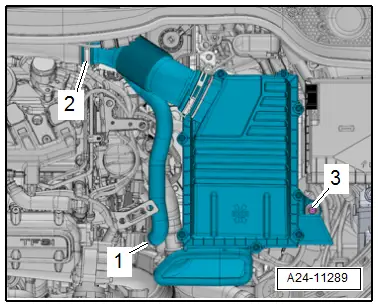
Continuation for All Vehicles:
- Disconnect the connector -1-.
- Remove the brake lamp switch bolt -2-,
- Remove the brake lamp switch down from the brake master cylinder and remove it upward from the retaining tab.
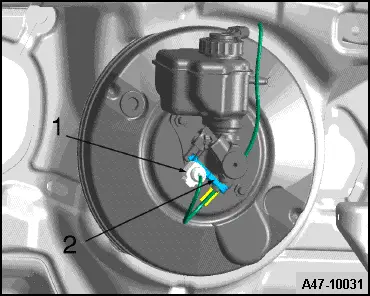
Installing
Install in reverse order of removal. Note the following:
 Note
Note
The brake light switch is not adjusted.
- Make sure that the brake lamp switch is seated correctly at top in the retaining tab.
- Tighten the brake lamp switch bolt.
Brake Booster, Removing and Installing
Special tools and workshop equipment required
- Brake Charger/Bleeder Unit -VAS5234- with Brake Bleeder Adapter -VAS5234/1-
- Sealing plugs from Repair Kit -1H0 698 311 A-
Removing
- Remove the vacuum in the brake booster by pressing the brake pedal repeatedly.
- Remove the air filter housing, refer to → Engine Mechanical, Fuel Injection and Ignition; Rep. Gr.24; Air Filter; Air Filter Housing, Removing and Installing or → Rep. Gr.23; Air Filter Housing, Removing and Installing.
Audi Q3:
- Remove the battery and the battery tray, refer to → Electrical Equipment; Rep. Gr.27; Battery; Battery Tray, Removing and Installing.
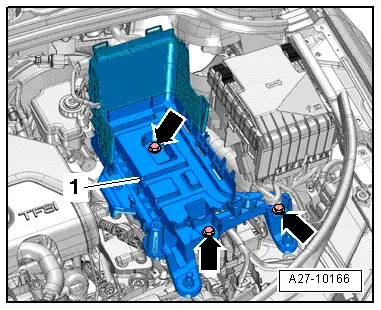
Continuation for All Vehicles:
- Disconnect the connector -2-.
- Remove the vacuum line -1- from the vacuum pump and brake booster. Set it aside with the vacuum hose connected.
 Note
Note
A vehicle with a 2.0L TFSI engine is shown in the illustration.
Vehicles with 2.0L TDI engine:
- Tie the air guide hose from the air filter housing to the turbocharger off to the side.
- Loosen the screw-type clamp on the air guide hose between the air guide pipe and turbocharger and turn it toward the rear.
Continuation for All Vehicles:
- Remove the brake master cylinder with the brake fluid reservoir, refer to → Chapter "Brake Master Cylinder, Removing and Installing".
- Disconnect the brake pedal from brake booster, refer to → Chapter "Brake Pedal, Removing from Brake Booster".
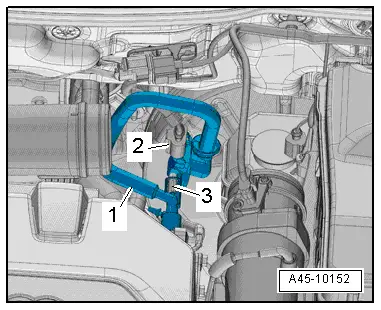
- Remove the nuts -1-.
- Remove the brake booster.
 Note
Note
Ignore item -2-.
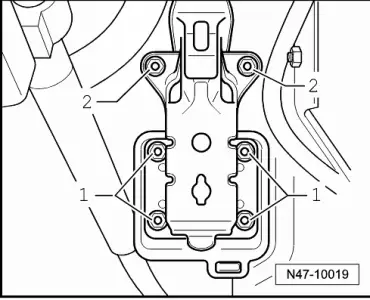
Installing
Install in reverse order of removal. Note the following:
- Attach the brake pedal to the brake booster, refer to → Chapter "Brake Pedal, Attaching to Brake Booster".
- Install the brake master cylinder, refer to → Chapter "Brake Master Cylinder, Removing and Installing".
- Bleed the brake system, refer to → Chapter "Hydraulic System, Bleeding".
- If applicable, bleed the clutch mechanism, refer to → Rep. Gr.30; Clutch Mechanism; Clutch Mechanism, Bleeding.
 WARNING
WARNING
Risk of accident!
Make sure the brakes are working correctly before driving the vehicle.
Tightening Specifications
- Battery tray and battery, refer to → Electrical Equipment; Rep. Gr.27; Battery; Overview - Battery.

